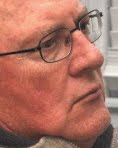
My notebook drawing above shows what might be a typical multiphase buck converter as a simplified block diagram of what a 3-phase system might be like (I don't claim to have inverted this.) The basic elements are a master control IC, slave gate drivers 1, 2, 3, and mosfet switches Q1-Q6. In a real implementation, the mosfet switches and gate drivers might be combined into one IC. One example similar to my drawing is the International Rectifier (TM) part iP2001. The main control IC usually has the basic functions of PWM signal generation, current and voltage sensing, frequency compensation, and some type of control bus which could be simply a set of external switches set to pull certain control bits up or down, an external microprocessor, or a serial bus such as an IC square (TM) or combinations of control methods. Each set of gate driver and pair of mosfets act like a separate high frequency synchronous buck converter as described in my previous article.
The three buck converters are paralleled into one system to form the 3-phase converter. Each phase operates in sync with the other phases at say 500KHZ each so the effective switching frequency is 1.5MHZ. Current is balanced in each phase by sensing the current in each inductor through the resistors R1, R2, and R3. Sometimes the current is determined by sensing the voltage drops across the upper mosfet in each pair, or by sensing the average current through the inductor. Inductors L1, L2, and L3 can be coupled for lower noise output. A complete description of the theory of coupling for lower noise is beyond the scope of the present article. Capacitors C1, C2, C3 represent possibly many capacitors in parallel that serve to filter noise and stabilize the converter. The inductance value, L1, for example and the effective capacitance C as the sum of all the capacitors set the pole and bandwidth of the converter as 1/(2*Pi*sqrt(L*C)) before compensation. The compensation network might be similar to the resistor-capacitor network shown between pins VSENS, FB, and COMP. Typical operating conditions could be a 12V input (Vi) and a 1.1 to 2V output at high currents. The 3-phase converter shown above could be capable of 60 amps output or more depending on the component ratings. The author designed and tested a 4-phase converter capable of 100 amps output at 1.2 volts with less than 15mv peak-to-peak noise. The typical application would be to power a low voltage microprocessor, graphics processor, or other processors that require large currents with high speed current demand pulses with low noise.


